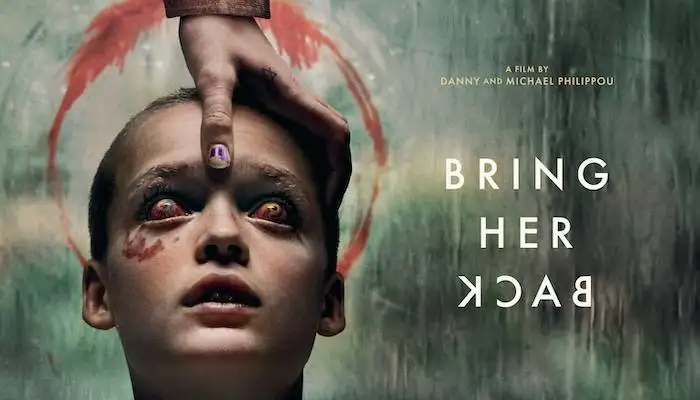BRING HER BACK Film Review | The Creepiest Movie of the Year

Bring Her Back Poster | Courtesy of A24
Bring Her Back is one of the most unnerving films to emerge from the genre in recent memory. Directed by twin brothers Danny Philippou and Michael Philippou, it’s a follow-up to their breakout debut Talk to Me, and confirms that their jump from YouTube chaos to cinematic precision isn’t a fluke. What began with backyard wrestling videos and lo-fi horror experiments has now evolved into something far more deliberate.
What is Bring Her Back About?
The story centres on two step-siblings, Andy (Billy Barrett) and Piper (Sora Wong), who are placed in a foster home after the death of their last remaining parent. Piper is partially sighted. Andy is struggling to adjust. At their new home, they meet their foster mother, Laura (Sally Hawkins), and another child, Oliver (Jonah Wren Phillips), who has already been living there. Oliver speaks rarely, and there’s something unsettling about his presence. It’s never clear whether he’s the cause of the strangeness in the house or simply another product of it. That ambiguity gives the film much of its shape.
The Cast of Bring Her Back

Sally Hawkins in BRING HER BACK | Courtesy of A24
The casting is strong, particularly in the small but important details. The teens look and act their age — braces, acne, and all the usual emotional defences. Andy and Piper’s relationship feels grounded. There’s tension, but also care, and the performances resist melodrama. According to the directors, Phillips was always the first choice for Oliver. While he does bear a passing resemblance to Stranger Things’ Eleven — something that took me a while to get past — it becomes clear pretty quickly why he was the obvious choice.
Still, it’s Sally Hawkins who carries the most weight. From her first appearance, something about Laura feels slightly off. At first it’s hard to place — a rhythm that’s just a bit too slow, or an expression that doesn’t quite match the words being spoken. But as the story unfolds, Hawkins begins to shift more dramatically between two sides of the character. She can turn a switch on and off — from warmth to something far colder — in a single breath or sideways glance. As Laura begins to spiral, Hawkins’ performance only sharpens. The contrast between the doting caregiver and the barely restrained threat becomes more difficult to watch — and harder to look away from.
That approach extended off-screen as well. Hawkins brought personal props to the set — small, second-hand items that helped shape Laura’s space. She stayed in character between takes, and the Philippous adjusted their process to accommodate her approach. Rather than resetting between shots, they kept the cameras rolling to see where she might take a scene. After production, she handed them a marked-up script filled with pages of character notes.
Sound Design and Cinematography in Bring Her Back
The film’s sound design, handled by Emma Bortignon, plays an equally important role. It’s not loud or obvious. Instead, it’s built from subtle, often uncomfortable layers — breathing, footsteps, wind, echoes. One moment in particular stands out: the sound of metal scraping on teeth. It’s not standard foley. It’s Danny Philippou, dragging a real knife against his own teeth. The final mix included over 700 layers, and it shows. The world feels enclosed and inescapable — even when nothing is happening onscreen.
Visually, Aaron McLisky (who also shot Talk to Me) keeps things mostly still. The film relies on slow zooms and patient framing. There’s restraint in how the camera moves, and the pressure builds without having to force it. In several key moments, the perspective shifts to Piper’s limited vision. These scenes use extremely shallow depth of field — with colours softening and edges blurring — allowing the viewer to see the world through her eyes. Focus snaps into place late in the shot, bringing us back to “our” reality after drifting through a version of Piper’s world.
The violence in Bring Her Back isn’t constant, but when it appears, it lands hard. It’s not sensational, but it is difficult to watch, and there were two scenes where I had to look away. The film doesn’t seem interested in shock for its own sake — but when it chooses to go there, it doesn’t pull back.
The final image is striking. No spoilers here, but some may find it symbolic in a way that feels a little too deliberate. Others will likely feel its weight. Either way, it is gorgeous, and will likely stay with you.
Is Bring Her Back Worth Watching?

Jonah Wren Phillips in BRING HER BACK | Courtesy of A24
At its core, Bring Her Back is about grief — and what people do to avoid confronting it. The film keeps returning to contradiction: inflicting pain in the name of healing, blaming others to avoid guilt, and embracing darkness in search of light. These ideas aren’t laid out plainly, but they sit just under the surface. For some viewers, the tension might feel so constant that it’s hard to engage with that deeper layer. Whether that’s a flaw or part of the design will depend on what kind of horror you respond to.
Either way, the Philippou brothers are worth watching. They’re not reinventing the genre, but they’re finding ways to take familiar ideas and give them a different shape. Their films feel stylized without losing track of story or performance — and they’ve consistently drawn something sharp and specific from the people they work with. Bring Her Back is a strong step forward.



